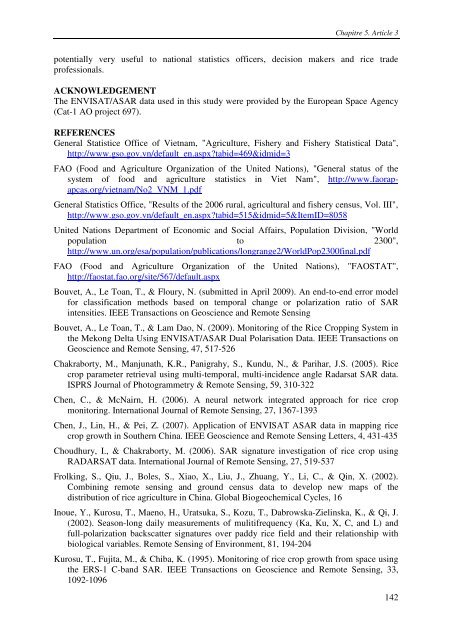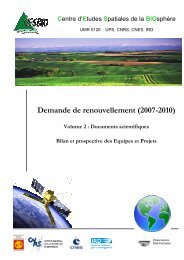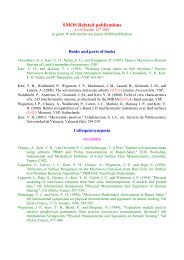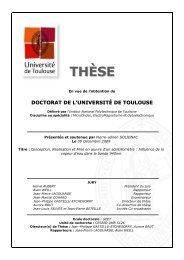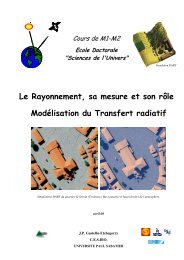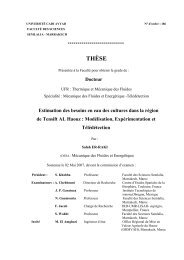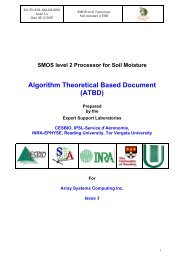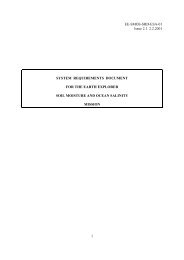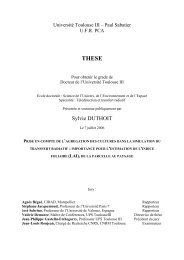THÃS EE - CESBIO - Université Toulouse III - Paul Sabatier
THÃS EE - CESBIO - Université Toulouse III - Paul Sabatier
THÃS EE - CESBIO - Université Toulouse III - Paul Sabatier
Create successful ePaper yourself
Turn your PDF publications into a flip-book with our unique Google optimized e-Paper software.
Chapitre 5. Article 3potentially very useful to national statistics officers, decision makers and rice tradeprofessionals.ACKNOWLEDGEMENTThe ENVISAT/ASAR data used in this study were provided by the European Space Agency(Cat-1 AO project 697).REFERENCESGeneral Statistice Office of Vietnam, "Agriculture, Fishery and Fishery Statistical Data",http://www.gso.gov.vn/default_en.aspx?tabid=469&idmid=3FAO (Food and Agriculture Organization of the United Nations), "General status of thesystem of food and agriculture statistics in Viet Nam", http://www.faorapapcas.org/vietnam/No2_VNM_1.pdfGeneral Statistics Office, "Results of the 2006 rural, agricultural and fishery census, Vol. <strong>III</strong>",http://www.gso.gov.vn/default_en.aspx?tabid=515&idmid=5&ItemID=8058United Nations Department of Economic and Social Affairs, Population Division, "Worldpopulation to 2300",http://www.un.org/esa/population/publications/longrange2/WorldPop2300final.pdfFAO (Food and Agriculture Organization of the United Nations), "FAOSTAT",http://faostat.fao.org/site/567/default.aspxBouvet, A., Le Toan, T., & Floury, N. (submitted in April 2009). An end-to-end error modelfor classification methods based on temporal change or polarization ratio of SARintensities. I<strong>EE</strong>E Transactions on Geoscience and Remote SensingBouvet, A., Le Toan, T., & Lam Dao, N. (2009). Monitoring of the Rice Cropping System inthe Mekong Delta Using ENVISAT/ASAR Dual Polarisation Data. I<strong>EE</strong>E Transactions onGeoscience and Remote Sensing, 47, 517-526Chakraborty, M., Manjunath, K.R., Panigrahy, S., Kundu, N., & Parihar, J.S. (2005). Ricecrop parameter retrieval using multi-temporal, multi-incidence angle Radarsat SAR data.ISPRS Journal of Photogrammetry & Remote Sensing, 59, 310-322Chen, C., & McNairn, H. (2006). A neural network integrated approach for rice cropmonitoring. International Journal of Remote Sensing, 27, 1367-1393Chen, J., Lin, H., & Pei, Z. (2007). Application of ENVISAT ASAR data in mapping ricecrop growth in Southern China. I<strong>EE</strong>E Geoscience and Remote Sensing Letters, 4, 431-435Choudhury, I., & Chakraborty, M. (2006). SAR signature investigation of rice crop usingRADARSAT data. International Journal of Remote Sensing, 27, 519-537Frolking, S., Qiu, J., Boles, S., Xiao, X., Liu, J., Zhuang, Y., Li, C., & Qin, X. (2002).Combining remote sensing and ground census data to develop new maps of thedistribution of rice agriculture in China. Global Biogeochemical Cycles, 16Inoue, Y., Kurosu, T., Maeno, H., Uratsuka, S., Kozu, T., Dabrowska-Zielinska, K., & Qi, J.(2002). Season-long daily measurements of mulitifrequency (Ka, Ku, X, C, and L) andfull-polarization backscatter signatures over paddy rice field and their relationship withbiological variables. Remote Sensing of Environment, 81, 194-204Kurosu, T., Fujita, M., & Chiba, K. (1995). Monitoring of rice crop growth from space usingthe ERS-1 C-band SAR. I<strong>EE</strong>E Transactions on Geoscience and Remote Sensing, 33,1092-1096142


